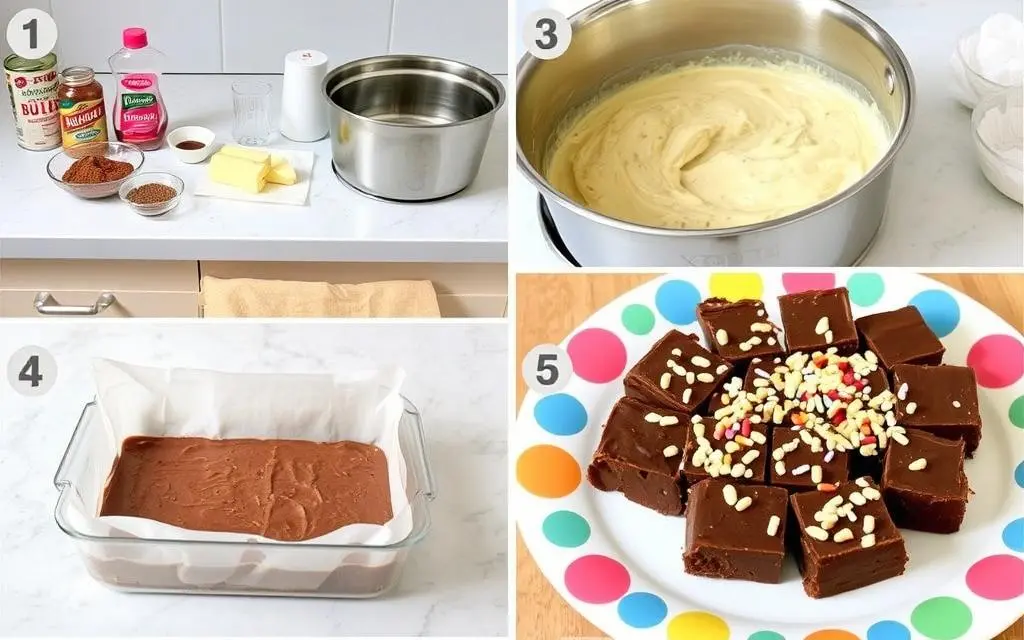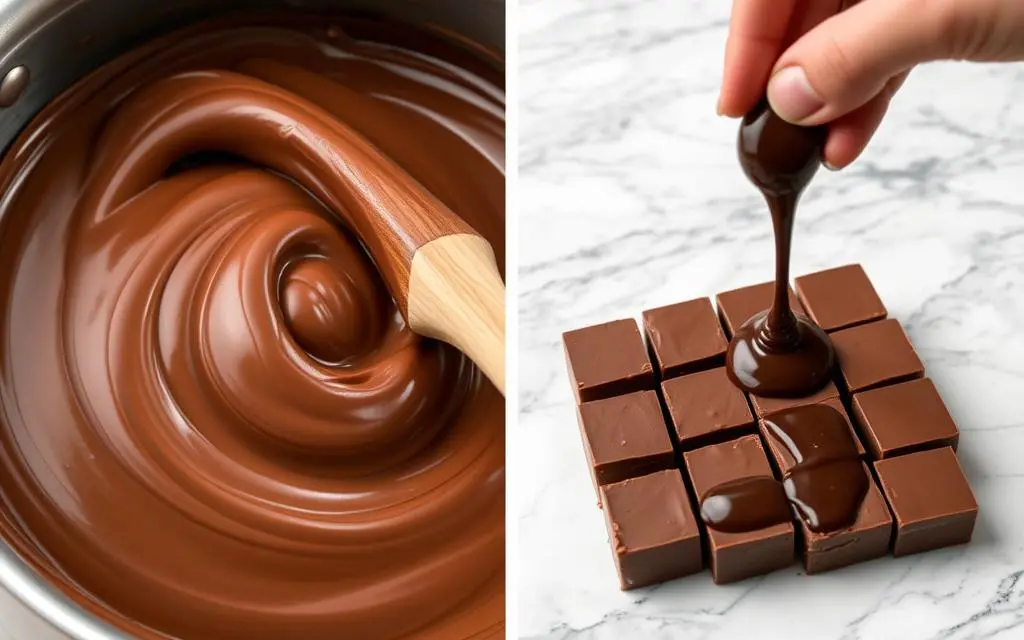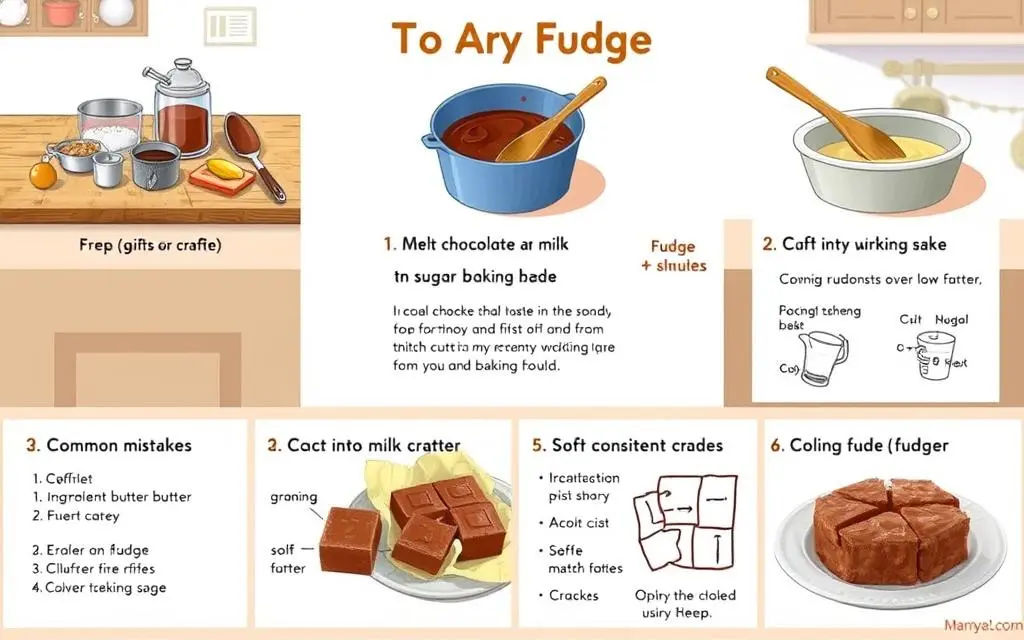Nothing beats the rich, smooth taste of homemade fudge. This classic treat, with its melt-in-your-mouth chocolate goodness, has been a favorite for generations. Surprisingly, making fudge at home is quite simple! Whether you’re a seasoned baker or just starting out, this recipe guides you through each step to create delicious, shop-quality fudge in your kitchen.
It will show you how to make delicious fudge that’s as good as store-bought. You’ll learn the steps to achieve the perfect texture and flavor.

Key Takeaways
- Homemade fudge is a rich, creamy, and indulgent confection that’s surprisingly easy to make at home.
- This easy fudge recipe provides step-by-step instructions for creating the perfect texture and flavor.
- Fudge is a versatile dessert that can be customized with a variety of mix-ins and flavors.
- With the right techniques and temperature control, you can master the art of fudge making in your own kitchen.
- Homemade fudge makes a thoughtful and delicious gift for any occasion.
Introduction to Classic Fudge Recipe Making
Why Make Homemade Fudge?
Homemade fudge is a delightful, indulgent treat that’s easy to prepare and makes a wonderful gift. In this guide, you’ll learn the techniques to achieve that perfect fudge texture and flavor that’s both creamy and smooth. Plus, fudge is incredibly versatile, letting you add in all kinds of flavors and mix-ins to make it your own.
Getting the Right Texture in Easy Fudge Recipe
The magic behind fudge’s texture is all about balance. A successful fudge recipe relies on careful attention to ingredients, cooking temperature, and timing to ensure the sugar crystallizes perfectly. Using a candy thermometer is essential, as it lets you monitor the temperature closely, creating that soft, melt-in-your-mouth consistency everyone loves.
Essential Tools for Making Fudge Recipe
You’ll need a few basic tools to make your fudge-making process smooth:
- Heavy-bottomed saucepan – for even heat distribution.
- Candy thermometer – to control the temperature accurately.
- Wooden spoon or silicone spatula – for consistent mixing.
- Baking pan or mold – to shape and cool the fudge.
Basic Fudge Recipe Chemistry
Fudge-making is all about the chemistry between sugar, milk, and other fudge ingredients. When heated, sugar molecules break down and recombine, creating the fudge texture. It’s important to control the temperature to get the right sugar crystallization and consistency.

“The trick to flawless fudge lies in balancing the ingredients precisely and maintaining proper temperature control.”
Essential Ingredients for Traditional Fudge Recipe
Making the perfect homemade fudge begins with choosing the right ingredients. The main parts of classic fudge are sugar, butter, cream, chocolate, vanilla extract, and marshmallow creme. These ingredients provide the rich, decadent flavor and texture that everyone enjoys.
Sugar is the base of fudge, adding sweetness and structure. Most people use white sugar, but you can try brown sugar or mix them for a richer flavor.
Butter makes fudge creamy and enhances its taste. Always use high-quality, unsalted butter for the best results.
Cream or milk – Helps create a soft, smooth texture. Using heavy cream results in a richer fudge, while milk provides a lighter texture.
Chocolate – Gives fudge its signature taste. Dark chocolate creates a bold flavor, while milk or white chocolate can add a sweeter touch.
Vanilla extract adds depth and rounds out the flavors in fudge.
Lastly, marshmallow creme can make fudge softer and fluffier, known as “creamy” or “fluffy” fudge.
By carefully selecting and balancing these ingredients, you can create the perfect homemade fudge that will truly satisfy your taste buds.

Ultimate Fudge Recipe: Step-by-Step Guide
Making perfect fudge needs careful steps. You must control the temperature, mix well, and cool it right. This ultimate fudge recipe will teach you how to make delicious fudge at home.
Temperature Control Tips
Maintaining the right temperature is crucial. Cook the mixture until it reaches between 234°F and 240°F – also known as the “soft ball stage.” This ensures your fudge will have the right texture: smooth, creamy, and not gritty.
Mixing and Beating Techniques
Right mixing and beating are vital for perfect fudge. Once your ingredients hit the soft ball stage, take the pan off the heat. Start beating the mix hard. This adds air, making your fudge smooth and creamy.
Setting and Cooling Process
The last step is setting and cooling your fudge. Pour the mix into a ready pan and let it cool down completely. This slow cooling is what makes your fudge rich and dense.
| Temperature Control | Mixing and Beating | Setting and Cooling |
|---|---|---|
| Reach the “soft ball stage” between 234°F and 240°F | Vigorously beat the mixture to incorporate air and create a smooth, creamy texture | Let cool in the pan completely for best results |

Common Fudge Recipe Making Mistakes and Solutions
Making perfect fudge is an art that can be tricky, even for experts. We’ve listed common mistakes and how to avoid them. This will help you make fudge that’s smooth and creamy.
Grainy Fudge
Grainy fudge is a big problem. Often caused by over-boiling the mixture or incorrect temperature. To avoid this, watch the temperature closely. Stop cooking when it hits 235°F (113°C).
Fudge That’s Too Soft
Fudge that doesn’t set often hasn’t reached the correct temperature or wasn’t allowed to cool fully. Make sure it cooks to the right stage, and let it set until completely firm before slicing.
Fudge That’s Too Hard
Fudge can become brittle if it’s overcooked. Always remove from heat promptly when you reach the recommended temperature.
| Common Fudge Mistake | Potential Causes | Prevention Tips |
|---|---|---|
| Grainy fudge | Improper temperature control, over-boiling sugar mixture | Monitor temperature closely, stop cooking at soft ball stage (235°F/113°C) |
| Fudge too soft | Insufficient cooking time, improper cooling and setting process | Heat ingredients to right temperature, allow fudge to cool completely before cutting |
| Fudge too hard | Overcooking, excessive boiling time | Keep close watch on temperature, stop cooking at soft ball stage |

“Achieving excellent fudge comes down to carefully managing temperature and timing. With some practice, you’ll master the art of fudge-making in no time.”
Flavor Variations and Mix-ins
Fudge lovers can get creative with different chocolate types and mix-ins. Try using dark, milk, or white chocolate, or mix them for a unique taste. For a nutty flavor, add chopped pecans, walnuts, or creamy peanut butter fudge.
Seasonal spices or fruits can make your fudge special for holidays. This turns your fudge into a delightful holiday fudge treat.
Classic Chocolate Variations
Try different chocolate types for a rich taste. Use dark chocolate for a deep flavor or milk chocolate for a creamy feel. Swirl in white chocolate or mix cocoa percentages for a special touch.
Nuts and Candy Add-ins
Chopped nuts like almonds or cashews add a nice crunch. Peanut butter makes a creamy and tasty nut fudge. Crushed candy canes, toffee bits, or marshmallow fluff add fun and playfulness.
Seasonal Flavor Ideas
Use seasonal spices like cinnamon or ginger to add flavor. For a festive look, add crushed candy canes or chopped pecans. A caramel swirl makes your fudge a special holiday fudge treat.
FAQ
What equipment is essential for making perfect fudge?
To make delicious homemade fudge, you’ll need a few key pieces of equipment. A heavy-bottomed saucepan, a candy thermometer, and a sturdy wooden spoon or spatula are must-haves. They help with stirring and mixing.
What are the basic ingredients in traditional fudge?
Classic fudge needs sugar, butter, cream or milk, chocolate, and vanilla extract. The way you mix these ingredients affects the fudge’s texture and taste.
How important is temperature control when making fudge?
Temperature control is key for perfect fudge. You need to heat the mixture to the “soft ball” stage, around 234-240°F. This ensures it’s firm but still creamy.
What are some common mistakes to avoid when making fudge?
Avoid overcooking, which makes fudge hard and grainy. Undercooking results in soft, gooey fudge. Also, improper cooling can cause crystallization issues. Focus on temperature and mixing techniques to avoid these mistakes.
Can I experiment with different flavors and mix-ins for my fudge?
Absolutely! The basic recipe is a great start, but you can add many flavors. Try different chocolates, nuts, candies, or seasonal ingredients. This lets you create unique fudge flavors.
